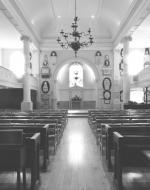Created by Hannah Stoughton on Mon, 10/07/2024 - 22:13
Description:
Image: "The Interior of St. Swithin's Church of Walcot in Bath" from Church Website.
Since human beings have begun using currency as a form of acquiring resources and goods, the acquisition of a larger amount of currency has been an extremely popular desire. This desire fuels wealth in society, where those who possess it have historically been viewed as superior to commonfolk. Wealth gaps and class distinction has been an important part of many different cultures, with many wealthy people unlocking privileges in society for simply possessing more of a way to attain resources.
According to "Reinterpeting Britain's Social Tables, 1688-1913," in a model done by Patrick Colquhoun in 1801 & 1803, the bottom 65% of all of his thirteen social classes possessed just 26.7% of the country's wealth. In recorded data from 1688-1913, the largest wealth disparities occurred between the years of 1803 and 1867, where the gap declined from 26.7% to 26.5% (according to Dudley Baxter) of all income shares being possessed by the bottom 65% of the social classes (Lindert and Williamson, 98). This wealth gap reflected across a variety of different sectors of society, with religion and churches being one of these aspects.
Within some Anglican churches, including St. Nicholas Church of Steventon, Hampshire (the church that Jane Austen's family attended for some time), the pews were separated based upon social class. Brenda Cox writes in her book "Fashionable Goodness," a study on Christianity in Jane Austen's England, "The central part of the church, the nave, held pews for the gentry. Poorer parishioners stood in the aisles or sat on benches, mats, hassocks, or in the galleries (balconies). Churches were chilly, and wealthy families built box pews with high walls to keep out drafts" (94) to indicate the class divide seen in Anglican churches. Jane Austen's family would have been in the pews, as they were members of the gentry.
The separation of poor individuals and families from gentry members represents the large class divide that Austen witnessed and commented on in her novels. When writing critiques on how some women viewed marriage, Austen indicated that some of her characters (such as Charlotte Lucas from "Pride & Prejudice") were too concerned with financial prospects in marriage instead of love and attraction. Witnessing severe class divide would have made her aware and more conscious of social class critiques within her writing.
Works Referenced
“Church of England ‑ Anglican Church.” History.Com, A&E Television Networks, www.history.com/topics/european-history/church-of-england. Accessed 8 Oct. 2024.
Cox, Brenda S. Fashionable Goodness: Christianity in Jane Austen’s England. Topaz Cross Books, 2022.
Lindert, Peter H., and Jeffrey G. Williamson. “Reinterpreting Britain’s Social Tables, 1688-1913.” Explorations in Economic History, pp. 94–109.
St. Swithin’s Church. The Interior of St. Swithin’s Church of Walcot in Bath. . St. Swithin’s Church, https://www.stswithinswalcot.org.uk/bookings.html.


